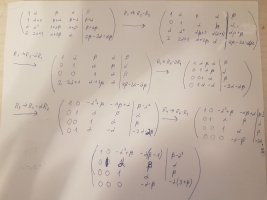TheWrathOfMath
Junior Member
- Joined
- Mar 31, 2022
- Messages
- 162
Please see attached file which includes a set of linear equations.
1. For what values of alpha and beta the system has one solution?
2. For what values of alpha and beta the system has no solutions?
3. For what values of alpha and beta the system has infinitely many solutions?
4. For every case in which the system has infinitely many solutions, find the general solution of the system.
1. For what values of alpha and beta the system has one solution?
2. For what values of alpha and beta the system has no solutions?
3. For what values of alpha and beta the system has infinitely many solutions?
4. For every case in which the system has infinitely many solutions, find the general solution of the system.


